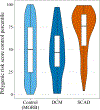Exploring the Genetic Architecture of Spontaneous Coronary Artery Dissection Using Whole-Genome Sequencing
- PMID: 35583931
- PMCID: PMC9388555
- DOI: 10.1161/CIRCGEN.121.003527
Exploring the Genetic Architecture of Spontaneous Coronary Artery Dissection Using Whole-Genome Sequencing
Abstract
Background: Spontaneous coronary artery dissection (SCAD) is a cause of acute coronary syndrome that predominantly affects women. Its pathophysiology remains unclear but connective tissue disorders (CTD) and other vasculopathies have been observed in many SCAD patients. A genetic component for SCAD is increasingly appreciated, although few genes have been robustly implicated. We sought to clarify the genetic cause of SCAD using targeted and genome-wide methods in a cohort of sporadic cases to identify both common and rare disease-associated variants.
Methods: A cohort of 91 unrelated sporadic SCAD cases was investigated for rare, deleterious variants in genes associated with either SCAD or CTD, while new candidate genes were sought using rare variant collapsing analysis and identification of novel loss-of-function variants in genes intolerant to such variation. Finally, 2 SCAD polygenic risk scores were applied to assess the contribution of common variants.
Results: We identified 10 cases with at least one rare, likely disease-causing variant in CTD-associated genes, although only one had a CTD phenotype. No genes were significantly associated with SCAD from genome-wide collapsing analysis, however, enrichment for TGF (transforming growth factor)-β signaling pathway genes was found with analysis of 24 genes harboring novel loss-of-function variants. Both polygenic risk scores demonstrated that sporadic SCAD cases have a significantly elevated genetic SCAD risk compared with controls.
Conclusions: SCAD shares some genetic overlap with CTD, even in the absence of any major CTD phenotype. Consistent with a complex genetic architecture, SCAD patients also have a higher burden of common variants than controls.
Keywords: acute coronary syndrome; connective tissue; genetic predisposition to disease; genome; phenotype.
Conflict of interest statement
Figures


Comment in
-
Dissecting the Genomics of Spontaneous Coronary Artery Dissection.Circ Genom Precis Med. 2022 Oct;15(5):e003867. doi: 10.1161/CIRCGEN.122.003867. Epub 2022 Aug 18. Circ Genom Precis Med. 2022. PMID: 35980654 Free PMC article. No abstract available.
References
-
- Diez-del Hoyo F, Sanz-Ruiz R, Diez-Villanueva P, Nunez-Garcia A, Casado-Plasencia A, Angulo-Llanos R, Clavero-Olmos M, Elizaga Corrales J and Fernandez-Aviles F. A novel cardiovascular presentation of Alport Syndrome: spontaneous coronary artery dissection. Int J Cardiol. 2014;177:e133–134. - PubMed
-
- Henkin S, Negrotto SM, Tweet MS, Kirmani S, Deyle DR, Gulati R, Olson TM and Hayes SN. Spontaneous coronary artery dissection and its association with heritable connective tissue disorders. Heart. 2016;102:876–881. - PubMed
-
- Kaadan MI, MacDonald C, Ponzini F, Duran J, Newell K, Pitler L, Lin A, Weinberg I, Wood MJ and Lindsay ME. Prospective Cardiovascular Genetics Evaluation in Spontaneous Coronary Artery Dissection. Circ Genom Precis Med. 2018;11:e001933. - PubMed
Publication types
MeSH terms
Supplementary concepts
Grants and funding
LinkOut - more resources
Full Text Sources
Medical

